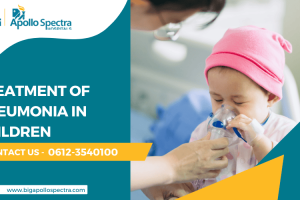An ongoing cough that gets worse or persists could indicate that your lungs are developing a serious problem. You might begin noticing signs that your cough is turning into pneumonia. Pneumonia affects millions of people globally every year and presents itself as a mild to severe illness, especially among vulnerable groups such as children, seniors and people with weak immune systems.
The ability to identify how a typical cough develops into pneumonia helps patients get better treatment results while minimizing medical problems.
The initial symptoms of respiratory infections are so alike that people find it difficult to tell if they have a common cold or are experiencing the early stages of pneumonia.
However, early identification of warning signs can lead to earlier medical intervention as well. This can help prevent long hospital stays and the need for aggressive treatment options.
So, for persistent respiratory symptoms, proper diagnosis and treatment options are crucial. Consulting with the best super speciality hospital in Patna can help you get comprehensive care under the guidance of expert pulmonologists and respiratory infection specialists.
6 Signs Your Cough is Turning Into Pneumonia
The presence of infectious agents in the lungs leads to the development of pneumonia. This essentially happens due to the inflammation in the alveoli.
As a result, these small sacs (alveoli) become filled with fluid or pus which naturally declines the oxygen exchange capacity. This ends up resulting in some of pneumonia’s typical symptoms that you might notice as the condition develops.
As a matter of fact, pneumonia is quite different from the symptoms of a viral cough. Where a normal viral cough will typically resolve within a few days, pneumonia has some distinct warning signs during its progression.
Understanding key differences like these will help you determine how to know if your cough is turning into pneumonia and when to get medical help. If there are symptoms that persist, you are better off getting in touch with your doctor instead of waiting for symptoms to go away by themselves.
Having said that, here are some of the symptoms that you should not underestimate and seek medical care at the earliest.
1. Persistent Cough That Worsens
The first giveaway sign of pneumonia is the duration for which the symptoms last. If coughing lasts for more than 2 weeks or gets worse, there’s usually something more than ordinary cough. Take note of the colour of phlegm as well.
If your dry cough has persisted and you are producing phlegm with colour, take heed. A viral infection is typically represented by clear or white mucus but bacterial infection, typical of pneumonia, frequently presents with yellow, green, or even rust-coloured sputum.
There can also be presence of blood in the sputum, which can lead to a metallic or unfamiliar taste sensation during coughing.
Moreover, the volume of coughing can be much more than what is seen in a typical cough. Coughing episodes in pneumonia can actually get pretty severe. It can lead to breathlessness or even cause vomiting to occur. Thus, you need to monitor your condition carefully and take note of the changing symptoms.
Many patients also report coughing getting worse during nighttime. During nighttime rest, lying down causes secretions to accumulate differently in the lungs. That’s why pneumonia-associated coughs intensify during the night hours when you are trying to sleep.
This intense coughing will most likely disrupt your sleep too and weaken immunity in crucial healing times.
Also remember that the productive cough of pneumonia produces a wet sound with mucus while bronchitis results in a dry, irritating cough. Seeking evaluation and treatment from a pulmonologist doctor in Patna should be your immediate step if you observe these symptoms appearing together.
2. Difficulty Breathing
Feeling shortness of breath, having accelerated breathing rates, or becoming quickly breathless during light activities indicates possible lung infection spread.
This happens because the normal process of oxygen exchange becomes disrupted when inflammation and fluid build-up occur. The respiratory distress causes adults to breathe over 20 times per minute which exceeds the normal rate of 12 to 16 breaths per minute.
The activation of neck or abdominal accessory muscles during breathing becomes apparent through visible contractions with every breath. As pneumonia worsens, blood oxygen levels decrease which can also cause lips or fingernails to develop a bluish tint, indicating cyanosis, which needs urgent medical care.
Patients suffering from pneumonia often express the difficulty in breathing as “air hunger” because they feel unable to draw a full breath despite more efforts.
Physical exertion causes this symptom to intensify even more. Even walking to the bathroom or talking in full sentences can trigger symptoms. In patients who already have asthma or COPD, their breathing difficulties can escalate to dangerous levels in a short period of time.
3. Chest Pain
Notice if coughing or breathing deeply causes sharp or stabbing pain. The presence of discomfort in this case usually means pleura inflammation which is a pneumonia complication.
When trying to differentiate between this type of pleuritic pain from other chest discomforts, notice the sensations. Pleuritic pain presents as sharp pain instead of dull, is focused on a specific location rather than spreading throughout the chest, and becomes much worse during coughing.
Patients often report that they feel as if a knife is stabbing them with every breath they take. However, whether the pain radiates to your shoulder or back will depend on the location of lung infection.
Severe pain makes patients take shallow breaths unconsciously to avoid discomfort, which can further result in insufficient oxygen intake and extended healing time.
Under healthy conditions, pleural layers glide without friction. However, inflammation creates friction between these layers which produces both pain and sometimes an audible sound that doctors can hear through a stethoscope.
Constant pain signals a potentially serious pleural effusion which requires draining the accumulated fluid when severe.
4. Fever, Chills, and Sweating
Fever exceeding 100.4°F (38°C) and also experiencing chills and night sweats usually indicates that your body is fighting a major infection. Also know that these symptoms are usually not typical of a common cold or bronchitis.
Moreover, fever patterns in pneumonia patients are often different from those common in standard respiratory infections. Antipyretics such as acetaminophen usually are enough to control the low-grade fevers from viral infections. On the other hand, pneumonia can lead to high-grade fevers that rebound once medication loses effectiveness.
You can experience fever patterns with temperatures that rise in the afternoon and evening and can hit extreme temperatures between 103-105°F (39.4-40.6°C) during severe episodes. It’s also common to experience chills that can create visible shaking and teeth chattering even when room temperature remains constant.
Moreover, there will likely be a frequent need to replace bedding or clothing because of the extreme amount of perspiration you experience from night sweats.
This kind of temperature dysregulation occurs because your immune system releases inflammatory cytokines during infection.
However, while we are at it, it’s also important to mention that not all pneumonia patients will develop fever. Lack of feverish symptoms is especially the case among elderly individuals. Those with weakened immune systems can also have an absence of fever. Thus, diagnosis of additional symptoms become even more critical for these cases.
5. Unusual Fatigue and Weakness
During pneumonia, your body usually expends more energy fighting the infection and maintaining oxygen levels. This is why you may experience extreme fatigue that’s beyond standard cold symptoms.
Normal tiredness is far from this type of fatigue because patients describe it as “bone-crushing” or debilitating. The fatigue symptoms during a pneumonia infection can, in fact, prevent you from performing even the most basic tasks such as showering or preparing meals.
Well, this kind of exhaustion is actually obvious due to multiple factors, including:
- The immune system uses energy to fight infection,
- muscles receive less oxygen due to poor oxygenation,
- disrupted sleep from coughing creates a sleep deficit, causing tiredness,
- and dehydration from fever worsens energy depletion.
Patients who suffer from pneumonia frequently describe their fatigue as a sudden onset condition, often appearing before any respiratory symptoms are noticeable. Weakness affects either the entire body or shows stronger symptoms in certain muscle groups.
Patients who show unanticipated lightheadedness or dizziness upon standing may be experiencing a reduction in blood pressure or insufficient oxygen delivery to their brain. This profound exhaustion continues even after fever subsides and may last for weeks during the recovery stage which distinguishes pneumonia from milder respiratory infections.
6. Changes in Mental State
Confusion and disorientation are among some of the advanced symptoms of pneumonia in elderly patients. In fact, older adults often experience cognitive changes as the initial and most noticeable symptom of pneumonia before even developing fever or cough.
The main cause behind these neurological symptoms in elderly is reduced oxygen levels that impair brain function. Also important to remember is that the symptoms can fall anywhere between mild and severe.
Usually, family members are the first to detect early symptoms through the patient’s difficulty in focusing and unusual behaviours. Plus, short-term memory issues can also be a tell-tale sign.
Moreover, increased oxygen deprivation can develop more intense confusion and disorientation, an inability to recognize people or places, or even hallucinations. Brain tissue suffers from low blood oxygen levels while inflammatory responses interfere with regular neurotransmitter functioning.
It’s easy to confuse the neurological signs of pneumonia with dementia or stroke symptoms, making diagnosis challenging. There’s a greater significance of caregivers and family members in identifying the changes in these cases because many times it’s hard to recognize the symptoms independently.
Medical Advice or Recommendations
You must seek immediate medical attention when you suspect pneumonia. Medical professionals diagnose pneumonia by conducting physical examinations and performing chest X-rays along with blood tests and occasionally sputum analysis to determine the infectious pathogen.
The choice of pneumonia treatments depends on the specific cause that’s causing the condition and how severe it is.
Antibiotics help treat bacterial pneumonia while viral pneumonia treatment options include antiviral medications and supportive care. In either case, your doctor will recommend:
- Complete rest to support healing.
- Increased fluid intake to help loosen mucus.
- Medications to lower fever and alleviate pain symptoms.
- Breathing exercises that enhance lung capacity to facilitate recovery.
Hospitalization may be required for intense monitoring and treatment of high-risk patients which includes people with chronic diseases as well as young children and adults who are older than 65 years. These vulnerable groups can benefit from pneumococcal vaccination and yearly flu shots to effectively prevent illness.
Learning about the mechanisms that cause cough when pneumonia develops allows for better understanding of symptom development.
The infection typically initiates inflammation within your lung air sacs, leading to fluid accumulation which blocks oxygen transfer while also generating a productive cough as the body works to clear these airways.
Breathe Easy—Get Checked for Pneumonia Symptoms!
The ability to identify when a regular cough progresses to the symptoms of pneumonia in adults may save lives. A persistent cough does not always lead to pneumonia, yet monitoring your respiratory health allows you to pursue medical care when needed, which helps prevent serious health issues.
Seek medical advice immediately if you or a loved one show signs of chest infection that match with some or all of the above-mentioned pneumonia warning indicators.
Big Apollo Spectra delivers complete pulmonology services through advanced diagnostic technology and skilled specialists. Search for the best pulmonologist near me in Patna to access qualified medical professionals who deliver the right diagnosis and treatment which will maximize your chances of a fast and full recovery.
Remember that pneumonia is not just a normal cough. It requires appropriate medical treatment because home remedies alone are typically insufficient to manage it. Thus, it’s important to be quick in seeking medical guidance once you notice the initial symptoms common in pneumonia.





